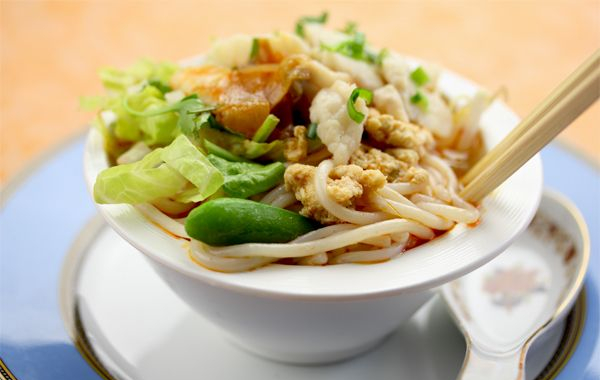The idea of eating hot soup during May sounds strange to many people. But in tropical countries, consuming hot broth at any time of the day (even for breakfast!) is normal. Odd as it is, hot liquid on a hot day does seem to help your body stay cool. With this factoid and the heat spike we’ve been experiencing in the Bay Area, I prepared bún canh do bien.
It has a sweet, red-colored broth (I used annatto seed oil to color it). The soup is fairly soft in texture: round, thick noodles are used and cá hong (red snapper), crab meat, shredded lettuce, bean sprouts and sugar snap peas are added at the last minute.
1. Info for Bun Canh Do Bien Recipe (Vietnamese Crab Noodle Soup)
- Cook Time: 25 mins
- Total Time: 40 mins
- Servings: 8
- Calories: 274kcal
2. Ingredients for Bun Canh Do Bien Recipe (Vietnamese Crab Noodle Soup)
- 8 cups Vietnamese turkey broth
- 2 tablespoons canola oil (or any neutral oil)
- 1 clove garlic, crushed and finely minced
- 1 teaspoon paprika
- 1 teaspoon annatto seeds (see tips)
- 1½ teaspoons mushroom seasoning salt (or regulat salt)
- 1 pound sugar snap peas
- 1 pound red snapper fillets, skinless, thinly sliced
- 1 cup crab meat
- 3 green onions, sliced
- 3 tablespoons chopped cilantro
- 1 cup combined Vietnamese herbs (lettuce, bean sprouts, mint, basil and cilantro)
- 1 teaspoon black pepper, freshly ground
- juice of 1 lime
- 2 packages round rice noodles (preferably the thick ones), soaked for 1 hour, then boiled
- 1 lime, freshly squeezed + extra for garnish
3. Directions:
- Prepping the sugar snap peas: Wash the peas; trim and pull any strings.
- Prepping the fish: Season with black pepper and red chili powder. Set aside.
- For the broth: Bring the soup back to a boil. Let simmer for about 10 minutes to make sure it’s warm enough.
- Prepping the crab:
- Into a pan, add the oil. Add garlic, paprika, the annatto seeds and crab. Sauté for 2 minutes. Dissolve a little warm broth into the mixture and bring to a boil; using a strainer, immediately transfer back to the stockpot, discarding the seeds.
- Check the seasoning. Adjust with more salt and pepper if necessary.
- Assembly (when you’re ready to serve):
- Bring the liquid back to a boil, add the 3 pieces. Regularly skim the impurities rising to the surface of the broth using a fine mesh strainer. Simmer for about 10 minutes. Add the sugar snap peas and green onions. Let it come back to a boil for a last time, cover and cook for 5-8 minutes.
- Drizzle with freshly squeezed lemon juice. Add bean sprouts (if you like) and more nuoc mam (fish sauce) if necessary. It’s ready! Serve immediately.
- Each person spoons some rice noodles into the bowl of canh (soup).
- Line up the serving bowls. Place some green onions and Vietnamese herbs in each bowl. Ladle the broth into the bowls with the pieces of fish and crab meat. Top with greens.
- Fill the bowls with more broth. Note: I wanted to showcase the ingredients from the soup, so I used a small bowl for the amount of liquid needed.
- Serve with nuoc cham, lime wedges and fresh chiles on the side.
- Serve immediately.
- Sprinkle with black pepper. Drizzle some nuoc mam into the broth to finish.
- Bon appétit!
4. Tips and advices:
- I prepared turkey broth with the bones from the ground meat I used for filming the egg roll filling yesterday.
- Make sure to choose young, bright green rau muong leaves so they are quite tender, especially the leaves.
- I used cá hong, which translates to “pink fish”. It’s a sweet fish that has a flaky texture when cooked.
- You can find rock sugar in any Asian stores. You can also use granulated sugar.
- Annatto seeds can be found in any Asian stores. They’re called hot dieu in Vietnamese and help provide a pretty reddish color to the broth.
- Mushroom seasoning salt brings a very distinct, earthy flavor to the sauce. You can find it at gourmet specialty stores or in most Korean stores.

